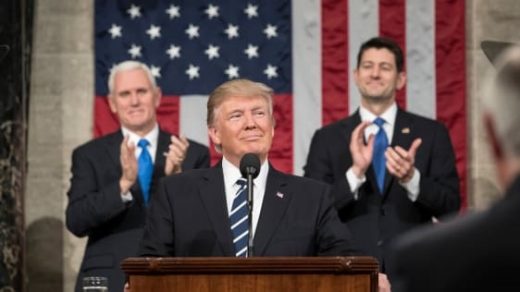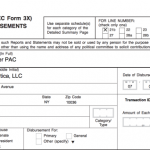This Little-Noticed Section Of Trump’s Tax Plan Could Make Corporate America More Responsible
Given Donald Trump’s reputation for being shortsighted, impulsive, and impatient, it would be no small irony if the president’s signature tax law spurs corporate America to think more about the long term.
Yet some believe it may do just that.
In a development that has received surprisingly little attention outside of law firm newsletters and corporate governance blogs, the new tax measure will sharply curtail the deduction that companies can claim when their senior executives are compensated under what are known as “pay-for-performance” arrangements.
Such remuneration—as encouraged by section 162(m) of the tax code—has typically come in the form of stock options and been tied to relatively short-run financial metrics, such as total shareholder return over a three-year period.
Critics have cited “pay for performance” as a major reason that executives have become obsessed with trying to pump up near-term profits and their company’s stock price—often by shedding jobs and cutting costs—while giving insufficient attention to longer-term investments and strategies that could ultimately benefit their own enterprise and society as a whole.
The fact that companies will no longer be able to take a big tax write-off for compensation that is calculated this way “is a huge deal,” says Lynn Stout, a Cornell law professor and the author of The Shareholder Value Myth, which offers a blistering critique of the myopia that afflicts many U.S. corporations.
Just how huge remains to be seen. Only a few companies, including Netflix, have said so far that they are revamping their pay structure in the wake of the tax law.
Stout cautions that stock-based “pay for performance” is so entrenched it isn’t going to disappear anytime soon. “It’s hard now to put the genie back in the bottle,” she says.
Perverse Consequences
Still, many of those who’ve studied corporate behavior have fingered section 162(m) as a key culprit in creating “an environment where,” as one business leader described it years ago, “a company’s long-term value and health are all too easily sacrificed at the altar of meaningless short-term performance.” Undoing 162(m), then, may well provide a real opening for reform.
Why this was made part of a tax law that was otherwise extraordinarily generous to business isn’t completely clear. But in its analysis of the legislation, the House Ways and Means Committee didn’t sugarcoat things, explaining that 162(m) has “led to perverse consequences as some executives focus on—and could, in rare cases, manipulate—quarterly results (off of which their compensation is determined), rather than on the long-term success of the company.”
How did we get into this mess?
To make a long story short—if you’ll pardon the expression, given the context—pressure began mounting in the 1970s for U.S. companies to do better for their shareholders in the face of slumping results and the rise of global competition. Having easily dominated world markets after World War II, America’s corporate giants had, in the view of many, gotten fat and lazy. Meanwhile, executives were accused of feathering their own nests, overlooking the welfare of those who’d invested in their businesses.
Prominent academics, especially Milton Friedman and Michael Jensen, made the case that this was backwards: An executive’s sole responsibility, they maintained, was to act as an agent of the shareholders. A business should be managed “in accordance with their desires,” as Friedman put it, “which generally will be to make as much money as possible.”
As a matter of law and history, what Friedman and Jensen argued was off-base. Executives don’t have a duty to “maximize shareholder value.” Their obligation is to be good stewards of the corporation’s assets, deploying them in the best interest of the company itself.
From Stakeholders To Shareholders
Nonetheless, “agency theory” was widely accepted, and by the mid-1980s putting shareholders ahead of all other stakeholders became the prevailing ethos in C-suites and boardrooms across the country. Through the 1950s and ’60s, top executives talked about advancing their companies by balancing the needs of all of their constituents—their employees, their customers, and the communities in which they operated. Suddenly, the shareholder was king.
Business schools reinforced this new norm. So did changes in compensation, which were designed to tie CEO pay more closely to a company’s stock price.
The amounts that executives pocketed ballooned accordingly. From the mid-1930s through the 1970s, large-company CEOs in the middle of the pack earned roughly $1 million a year in today’s terms. Their pay—including salary, bonuses, and stock options—held remarkably steady decade after decade. Then, in the 1980s, $1 million turned to $2 million.
A backlash erupted. “How can we ask people working and still not having enough money to pay their bills to be responsible when they know that the heads of the biggest companies in this country raised their pay by four times the percentage their workers’ went up?” Bill Clinton asked as he announced his run for the White House in the fall of 1991. Blasting “outrageous executive pay,” he vowed to limit to $1 million the compensation that companies could write off as a business expense on their taxes.
In 1993, Congress passed and Clinton signed a law imposing the $1 million ceiling. But as laid out in 162(m), the cap was chock-full of loopholes. Among them: Companies could still get a tax deduction beyond $1 million in pay so long as they tied this compensation—doled out as stock options—to “performance.”
An Explosion In Executive Pay
“By the time the lobbyists jumped in,” noted the late Graef Crystal, an expert on the topic, “the final regulations emasculated the law’s intent.” The entire situation, he said, was “a farce.”
Rather than being tamped down, median CEO pay kept going up and up—doubling again to $4 million in the 1990s. It currently stands at more than $11 million.
“It was 162(m) that . . . led to an explosion in executive pay,” Stout says.
All the while, evidence has piled up that executives have become increasingly incentivized under this system to try to jack up their company’s share price—all other considerations be damned. After all, it’s not only certain elements on Wall Street, looking to make a quick buck, that are pushing them in this direction; it’s generally in their self-interest to do so.
The Investor Responsibility Research Center Institute recently highlighted scholarly papers showing that the vesting schedules for compensation—that is, when a CEO can sell stocks and options—influence the likelihood that a company will revise earnings guidance upward; reduce research and development and capital expenditures; buy back shares in an attempt to drive up the price; and even enter into merger and acquisition activity.
Executives used to behave differently. Economist William Lazonick has found that in the 1970s, big companies usually paid out about half of their profits to stockholders. The other half was reinvested in R&D, worker training, employee compensation, and other areas meant to improve the fortunes of the company over time. Over the past 10 years, however, 94% of profits have gone to benefit shareholders directly through buybacks and dividends.
As short-termism has worsened, even some shareholders—institutional investors with an eye on how a company will fare over a longer time horizon—have become concerned that “pay for performance” has really become pay for non-performance.
No Shortage Of Skeptics
All that said, some are deeply skeptical that overhauling 162(m) will have much impact (and at this stage it’s most definitely not, with the windfall that corporations have enjoyed from the Trump tax cut flowing disproportionately to share buybacks rather than to higher wages and bonuses for workers).
That’s, in part, because losing deductibility may not be a strong enough motivation for companies to shift course.
What’s more, the practice of linking CEO pay to stock price was already well underway before 162(m) was put on the books. “This was a preexisting trend” among many companies, says Michael Dorff, a professor at Southwestern Law School in Los Angeles and the author of Indispensable and Other Myths: Why the CEO Pay Experiment Failed and How to Fix It. “I am convinced they will continue to use performance pay, regardless of the tax policy.”
Others observe that activist shareholders are sure to continue to judge a CEO’s effectiveness by where the stock price sits on any given day—and it can be difficult for even strong-willed boards and executives to thwart them in pursuit of a longer-term vision.
“A lot of investors think we should increase our reliance on stock-based compensation”—not move away from it, says Doug Chia, executive director of the Governance Center at The Conference Board and the former corporate secretary at Johnson & Johnson.
Some insist that if companies drift too far from the compensation model that has been in place, it could leave them less well-governed. Anything that decreases “the transparent and objective pay-and-performance alignment between shareholders and executives will be viewed negatively,” David Kokell, the head of U.S. compensation research at Institutional Shareholder Services, the proxy-adviser firm, has warned.
The question is: What should constitute “performance,” and over what time frame?
As companies contemplate this, more may want to use alternative metrics, gauging a CEO’s performance beyond the financial realm to take into account innovation, social responsibility, employee engagement and development, customer satisfaction, and so on. Any corporation inclined to try this, however, is “going to have to craft a convincing argument that institutional investors buy into,” says Matthew Goforth, senior governance advisor at Equilar, a compensation analytics firm.
Actually, after years of watching “pay for performance” get so out of whack, they seem quite ready to listen.
“There was a growing concern that 162(m) was leading to unintended consequences,” says Glenn Davis, director of research at the Council of Institutional Investors. Many pension funds and asset managers “are thinking hard now about how compensation can change to focus on long-term outcomes. There is an appetite for experimentation. The end of 162(m) is an important step.”
Indeed, with almost no fanfare, it may eventually turn out to be the most positive thing that Trump has done for the working class.
Fast Company , Read Full Story
(24)














